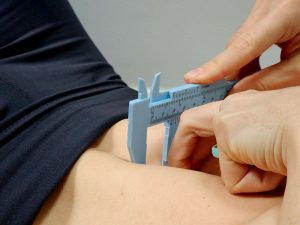Written by Bryn Zolty, PT
Supine Diastasis (DRA) Tests
An abdominal diastasis (DRA) is a weakness in the anterior abdominal wall in the connective tissue between the muscles. This condition can occur after prolonged stretching of the connective tissue and therefore is commonly seen related to pregnancy. Some pregnant women may report that when they try to exercise that they see a doming occur in the middle of their abdomen.
Most people are familiar with how to test for diastasis rectus abdominis (DRA) by doing a partial crunch to lift your shoulders off the ground. Then you place your fingertips into the middle of the abdomen and feel for a gap. Frequently, the width of the gap is measured in centimeters, or roughly estimated with how many fingers can be inserted into that space.
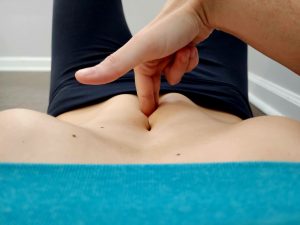
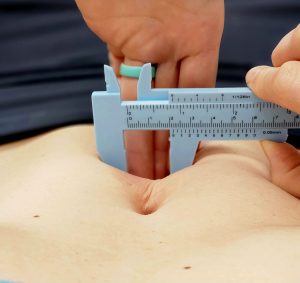
However, there is so much more to consider than just width! Let’s look at a few other things that can help you check your abdominal wall function. A DRA is an alteration to the core that can change the way the body manages its pressure. This means it alters how your body handles the workload you place on it daily. There are many meaningful tests that can be done standing, sitting, lifting, or in other positions. However, this will focus on the supine, or laying on your back, tests.
Curl Up Test
Lie down and curl your shoulders up off the ground. Ask yourself each of the following questions while you are in that partial crunch:
Is there doming or sinking in the middle of the gap?
If you saw doming, did you hold your breath?
Try the movement again during an exhale.
Look at the photos below. Here is a woman with 4-finger DRA and no doming during a crunch! This is why we don’t rely on just one test.
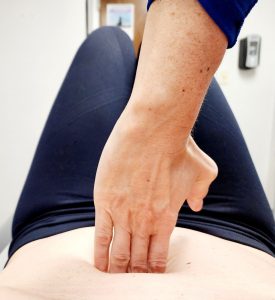
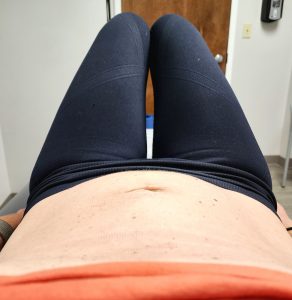
Now, gently press into the gap at several locations above, below, and at the belly button. How does it feel when you press down? Is it firm or soft? How deep can your fingers sink? Ideally, it would be hard to get 2 fingers inserted. Also, there should be tension or firmness when you press in. This indicates the deep abdominal muscles are supporting you and your fingers would not sink in deeply. The picture below demonstrates a narrow, softer, slightly deep gap, and lack of deep abdominal muscle tension.

Next, if you press on the sides of the gap, these are the rectus abdominis muscles, the “6-pack” muscles. Are they easy to move if you push them out wide? Or does the muscle tension give you resistance?
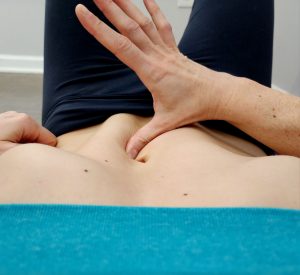
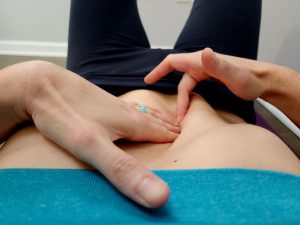
What is happening around the gap? We would hope for a relatively flat abdomen. Can you see each separate muscle group similar to the picture below? This could indicate the deeper core, including the transverse abdominis, is not recruiting well. This could possibly be an issue with its strength or the coordination of the abdominal muscles.
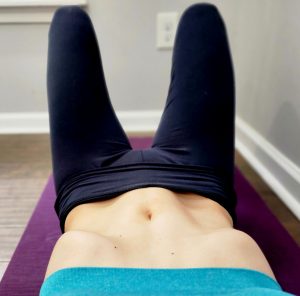
What do the ribs do when you curl up your shoulders? We watch the rib angle to get an idea of which muscles are working. The rib angle should not change much. Note the wide, pronounced ribs below. Two possibilities for this wide rib flare could be an oblique muscle dominance or weak transverse abdominis.
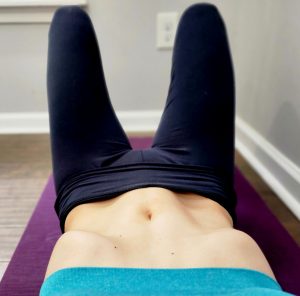
There are many other tests to check the function of the abdominal wall beyond the curl up test. They just aren’t all over the internet. As physical therapists, the focus is not just on the width of the gap, but more on how your body handles the work required to move and participate in the activities that you love.
Three additional supine DRA tests beyond the curl up test include: actively lifting a straight leg, a bent knee leg raise, and a cough test.
Active Straight Leg Raise
First, lay on your back, bend one knee as shown. Place your hands on either side of the front of your pelvis. While keeping the other leg straight, slowly raise it up to the height of the opposite bent knee.
Ask yourself these questions:
What happens to your pelvis?
Does your back arch?
Is one side more difficult than the other?
Is there any discomfort?
Do you hold your breath?
Below, notice the high back arch and ribs flared up.
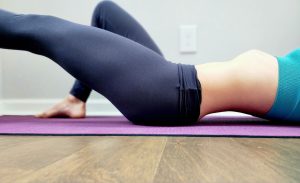
Check back at the muscle checks we did with the curl up test with your leg raise, how did you do?
Does one side of your hips/pelvis raise and rotate? A strong deep core would prevent/limit rotation during this task. This individual had a high degree of pelvic rotation. Look at the hands resting on the front pelvic bones to see that the right side is higher when the left leg starts to raise.
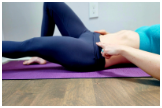
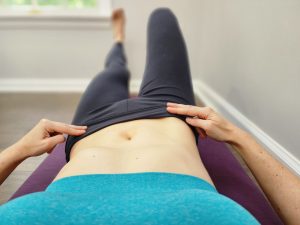
Lay on your back, place your hands on your lower abdomen and pelvis. Bend both knees and place your feet flat. Lift one leg up and observe the abdomen, then lift the other leg as shown below. If you had a large dome or your abdominal wall pushed towards the ceiling, lifting one leg only may be a better starting point.
The first photo demonstrates the ribs flaring up, back arching high off the ground.
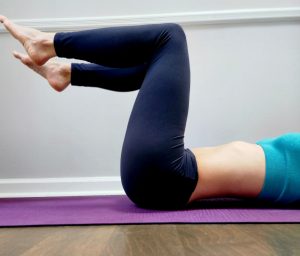
The second photo, below, demonstrates doming and pronounced 6-pack muscles. This woman did not dome with a crunch, but has difficulty managing the work required to lift both legs.
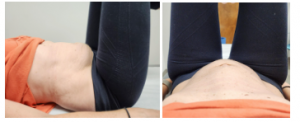
Cough Test
Lying on your back, try to cough and observe the abdomen. What happens? Coughing, laughing, sneezing, are everyday activities that require pressure to be managed by the core. Again, this woman did not dome during the curl up test, but pictured below is her doming with a cough.
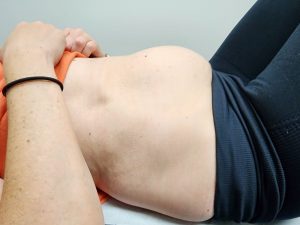
This is obviously not an all-inclusive list of tests. At JAG PT we check many other factors involved to determine your plan of care. These are supine screening tests that you can use to determine if you would benefit from a visit to a PT.
We highly encourage you to see a pelvic PT if experiencing these symptoms to check what the pelvic muscles are doing during these tasks. Our pelvic therapists are trained to check your pelvic muscles to see if they manage your pressure well and support you during these movements. The pelvic floor can also demonstrate a similar “doming” movement that is not so visible. The deep core works with the pelvic floor and checking that relationship can be vital to strengthening your abdomen, preventing pelvic organ prolapse, and eliminating urinary and bowel dysfunctions that can arise.
Our hope is to spread knowledge to not just judge your core or exercise capability based solely on the width of the gap! Too many individuals tell us they are limiting activity and exercise because they have a DRA. Let’s talk about your screening results and calm your fears about gaps and doming. If you have questions on your DRA and hope to get help returning to whatever you love, call our therapists today and get started.

